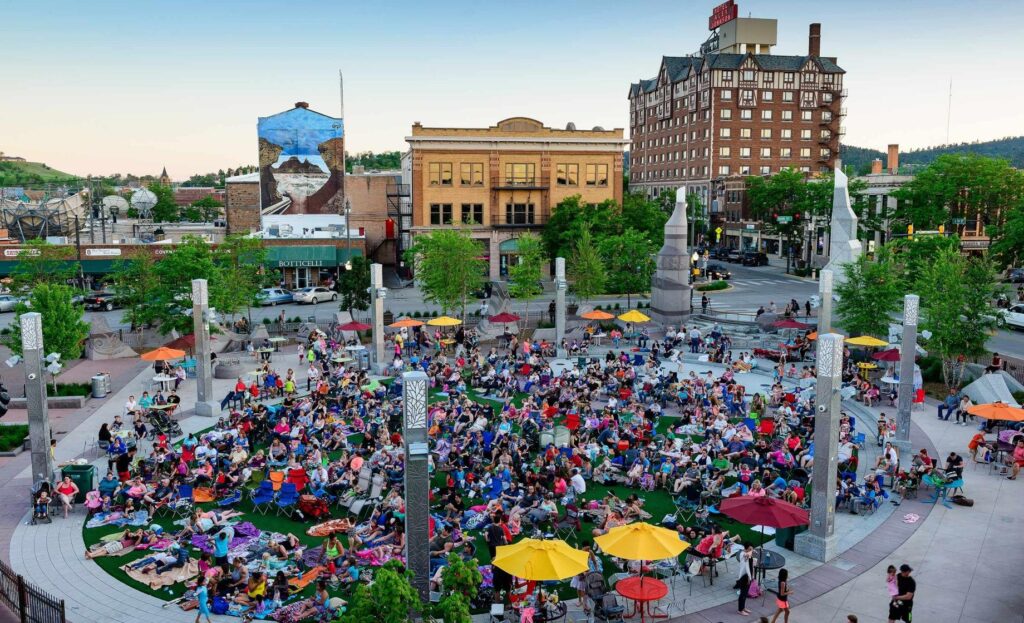
Makenzie Huber, South Dakota Searchlight
After the state declined to seek federal grant money to reduce greenhouse gases and other air pollution last year, Rapid City was the only city in South Dakota to apply for the money.
Now, the second largest city in the state has worked through its $1 million planning grant and will apply for an implementation grant of up to $50 million to invest in more energy efficient systems and potentially pilot renewable energy programs. The entire grant pool through the Environmental Protection Agency for implementation is $4.6 billion nationwide.
The $1 million planning grant was spent on contracting a company to analyze Rapid City’s greenhouse gas emissions and prepare a report, efforts to gain feedback, supplies and a portion of the sustainability department’s salaries.
Monday night, the Rapid City Council authorized the city’s sustainability program to apply for the implementation grant by April 1. However, the council amended its agenda item to only authorize the application, leaving the ability to accept any potential grant funds up in the air.
Lysann Zeller, Rapid City’s program development manager for sustainability and stewardship, told councilors that the EPA plans to award implementation grants in the fall.
The 2022 Inflation Reduction Act allocated Climate Pollution Reduction funding for state and municipal government projects that reduce greenhouse gas emissions and help mitigate climate change. Greenhouse gases such as carbon dioxide and methane trap heat in the atmosphere. Getting to “net zero” greenhouse gas emission requires reducing energy consumption, which can be done through energy efficiency upgrades, and switching to renewable energy sources.
Rapid City’s plan currently focuses on city, school and nonprofit improvements, and it does not seek to regulate private business or residential emissions.
Some council members were hesitant to sign off on the application. Councilor Kevin Maher said some of the items in the plan “are just unrealistic.”
There’s also concern that the plan might cost more than what the grant provides. Councilor Bill Evans dismissed that concern.
“I believe the council already has a failsafe, because we’re not allowed to spend money that the council hasn’t approved, so if it hasn’t been previously approved it wouldn’t go through anyhow,” Evans said.
Zeller said the city wouldn’t be beholden to the plan as it’s drafted now, and that Rapid City has time to polish it and get more feedback. The city must provide a comprehensive climate action plan by August 2025.
Zeller spoke to South Dakota Searchlight after the council meeting. She said some concerns about the plan stem from a “misunderstanding” among some utility providers that the EPA would mandate items listed in the plan.
“That’d be entirely up to our city council or other people in the community,” Zeller said. “I don’t expect many of these things will be mandated in the near future, but the plan gives us information and ideas if we do want to move forward.”
The draft, which was submitted to the EPA on March 1, analyzes Rapid City’s energy use and greenhouse gas emissions. Electricity, which primarily burns fossil fuels, Zeller said, accounts for half of the city’s greenhouse gas emissions – including residential, commercial and industrial emissions. Transportation, including vehicles, accounts for a quarter of emissions.

Based on the greenhouse gas inventory, using 2021 data, the city’s per capita greenhouse gas emissions stand at 19.66 metric tons of carbon dioxide equivalent, which is above the national average of 14.9, according to 2022 data from the global carbon budget.
“We have high greenhouse gas emissions in the U.S., particularly high in South Dakota because of our electricity source as well as the fact that we all drive to go anywhere since we’re such a rural state,” Zeller said.
The plan’s “short list of ideas” includes efforts to increase energy efficiency in specific public and nonprofit buildings, update lighting to energy efficient LEDs and invest in renewable energy pilot projects. According to a preliminary budget released in late February, the plan could cost over $37 million, with nearly $16 million of the money spent on emergency efficiency improvements for Rapid City area school buildings serving primarily low-income students (improving all Rapid City schools would cost over $37 million alone). The plan includes an amount to be determined for staffing, inflation and other indirect costs.
Many of the Rapid City Area Schools facilities are decades old.
“RCAS has a lot of old facilities and a lot to gain from making energy efficiency improvements not only to improve costs but improve working conditions for teachers and learning conditions for students,” Zeller told South Dakota Searchlight. “It’s a no brainer — low hanging fruit for the community.”
The plan also includes upgrading sports field lighting to LEDs across the city and investing in renewable energy programs, such as a South Dakota Mines campus pilot focusing on rooftop solar and geothermal energy and another program installing solar panels on the city’s water reclamation facility. Owned and operated by the city, the system could offset the facility’s electricity use and sell excess generation to the local energy grid, according to the report.
“The objective of this initial priority community climate resiliency plan was not necessarily to determine what’s feasible,” Zeller said. “It was simply to collect ideas from a variety of stakeholders and get input from different folks.”
